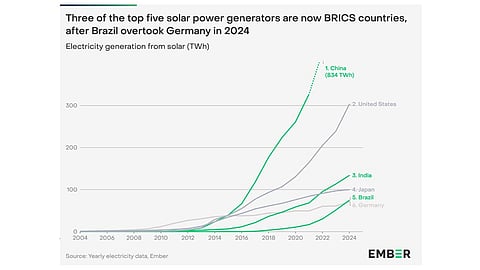

BRICS nations can now produce over 50% of the global solar electricity, up from 15% a decade ago
China alone generated 834 TWh in 2024, with India and Brazil cementing their place in the top 5 globally
A fall in solar and battery module prices in the near future will further strengthen the case for solar power in BRICS nations
China’s rapid solar build-out has helped propel the 10-member BRICS nations into global clean energy leadership, according to a new analysis by market intelligence firm Ember. The bloc now generates more than half of the world’s solar power.
In 2024, Brazil, Russia, India, China, and South Africa (BRICS), along with the newer members – namely Egypt, Ethiopia, Indonesia, Iran, and the UAE— accounted for 51% of global solar electricity generation, up sharply from just 15% a decade ago.
This shift highlights a major pivot toward cleaner growth in key emerging economies, according to Ember’s analysis, Solar BRICS: Emerging economies now lead the world’s clean energy race.
China, of course, is in the driver’s seat, making up 39% of the global solar generation in 2024, increasing its share from 14% in 2014. India accounted for 6.3%, followed by Brazil with 3.5%, and South Africa and the UAE making up 0.9% each. The remaining BRICS nations together contributed 0.5% of the global total.
Of the top 5 solar countries globally, 3 are now members of this intergovernmental organization. China, with its 834 TWh of solar electricity generation in 2024, topped the list. India and Brazil were among the top 5, with 133 TWh and 75 TWh of solar energy generated.
Altogether, Ember estimates solar power generation across the 5 original BRICS nations to have gone up by 39% between January 2025 and April 2025, compared to the same period in 2024. In specific volumes, China added 98 TWh during 4M 2025 with a 42% year-on-year (YoY) increase, India saw 32% growth to 14.1 TWh, followed by Brazil, which increased its solar generation during the 4-month period by 35% to 7.9 TWh.
China's clean electricity growth is outpacing demand growth so far in 2025, resulting in a decline in fossil fuel electricity generation. In the first 5 months of 2025, China’s solar energy generation increased 120 TWh, meeting 86% of the 139 TWh increase in demand.
Overall, solar accounted for more than a third of the BRICS countries' electricity generation increase in 2024, as per the analysts.
“BRICS countries are no longer on the sidelines of the clean energy transition – they are driving it,” said Ember Senior Electricity Analyst Muyi Yang. “Ahead of the summit, these numbers send a clear message: the bloc has the momentum and the opportunity to lead with greater ambition while strengthening energy security and reducing reliance on fossil fuel imports.”
“The fall in solar and battery module prices will only further strengthen the case for solar power in BRICS nations,” reads the analysis, which is available for free download on Ember’s website.
In a recent analysis, Ember declared that solar with batteries can deliver near round-the-clock electricity at competitive costs, thanks to the decline in battery prices (see Batteries Can Unlock '24/365 Solar Generation', Says Ember).
